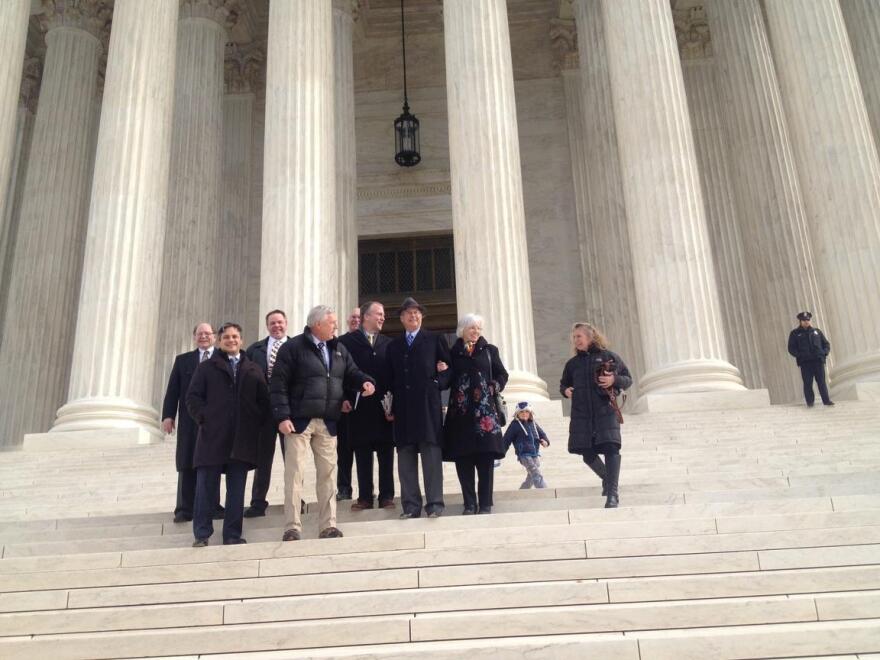The justices of the U.S. Supreme Court this morning debated whether the Park Service can impose its rules on rivers that flow through Alaska’s national park units. The case began in 2007, when rangers in the Yukon-Charley Rivers National Preserve told Anchorage moose hunter John Sturgeon he couldn’t operate his hovercraft there. It has morphed into a debate on federal over-reach, the Park Service’s duty to protect rivers and the meaning of a single sentence in ANILCA, the Alaska National Interest Lands Conservation Act.
Sturgeon, a former state forester, was in the chamber today to hear the complex legal arguments spawned from that encounter with Park Rangers more than eight years ago.
“Well, I think it was a great experience," he said afterward. "I learned a lot. I don’t quite understand all the nuances. That’s what they attorneys are for. And it’s a privilege to be here.”
The justices for a while seemed stumped by a single word: “Solely”. The context: When Congress passed ANILCA in 1980, it created a lot of new national park and preserve lands in Alaska. ANILCA says the Park Service can’t treat the state and private lands that were engulfed by these new conservation units as though they are park lands, too. ANILCA says non-federal lands -- and waters -- are exempt from rules that apply “solely” to federal land "within such units." But defining the rules that don’t apply is a puzzle at the heart of the Sturgeon case.
Sturgeon’s attorney, Matthew Findley, argued none of the Park Service rules apply to a navigable river, like where his client was, because the feds don’t own the river. Sturgeon lost in the lower courts. The 9th Circuit Court of Appeals ruled that non-federal areas of a park, like the river, are only exempt from Alaska-specific park rules. That court reasoned that the hovercraft ban is national -- not written solely for application within Alaska park units -- so it's enforceable. Justice Samuel Alito pressed the government attorney to disavow that reading of “solely” in ANILCA.
"Why don’t you concede that it’s wrong?" Alito asked. "It’s a ridiculous interpretation, is it not?"
The packed chamber erupted in brief laughter.
Justice Sonia Sotomayor invited the government attorney, Assistant Solicitor General Rachel Kovner, to give the decision a kick.
"It's wrong," Sotomayor said. "And walk it through, their argument, and tell me why they are wrong."
Outside the court, the attorneys involved talked to reporters.
Valerie Brown, legal director of the environmental law firm Trustees for Alaska, wrote a brief backing the Park
Service. She says the justices seemed to be rightly focused on navigable waters, not distracted by questions about private and state land.
“Basically, the Park Service has always managed navigable water, since its inception," she said. "And it clearly has the authority to do that (in Alaska) because ANILCA says to the Park Service: 'Go and manage these rivers. You have to allow motorboats and you have to allow plane landings, but you make all the other decisions, you protect the park resources. You’re here to protect fish and wildlife.'”
Jon Katchen wrote a brief supporting Sturgeon on behalf of Alaska’s congressional delegation.
“I think it’s a complicated case with complicated issues," he said. " was definitely pleased that everyone seemed to be on board that the 9th Circuit decision has to go out the door.”
He says the Supreme Court has a lot of options. It could overturn the 9th Circuit’s holding, and still rule in favor of the Park Service on other grounds. Or it could rule for Sturgeon. Or Katchen says, it could send the case back down and instruct the 9th Circuit try again.
“I may be misreading the court, but certainly it seemed like two or three or four of them were a bit confused by the case and how they wanted to proceed,” he said.
As for John Sturgeon, he says he still goes on his annual moose hunt, in the same area, but he takes his jet boat or a small airboat. Sturgeon says he’s had no more confrontations with Park rangers.
“They’ve kind of avoided me," he said. "In fact, I go on this side of the river and I see them going on that side of the river.”
He says the hovercraft is in his yard in south Anchorage, under a blue tarp.
“I’ve still got it. Then engine is in the garage, and when I win, I’m going to put it back in and I’m going to go moose hunting again," he said.
There’s no telling when the court will issue its opinion, but almost certainly before the current term ends in June.





